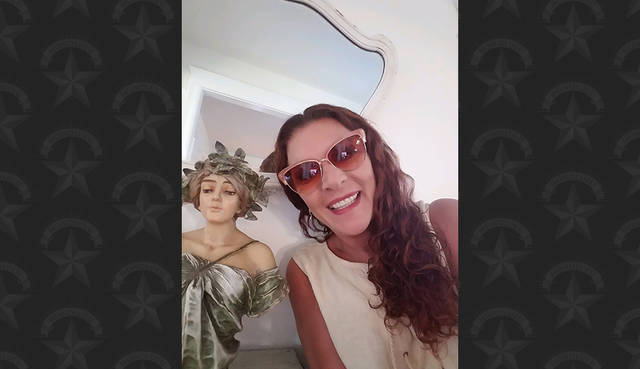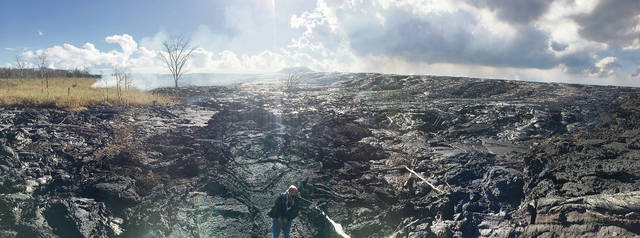Lava’s ravages take a toll on residents’ mental health

COURTESY KATHY URSO
Kathy Urso, 66, was among the first residents to lose a home to lava in picturesque Leilani Estates. “I just get really sad. If I wasn’t on my medication, I’d probably be suicidal.”

U.S. GEOLOGICAL SURVEY
Overflows from fissure 8’s channel produce shiny black to silver pahoehoe flows that are building up the channel margins and making the levees more robust.

PAHOA, Hawaii >> Kathy Urso’s house was surrounded by wild orchids and more than half a dozen fruit trees.
She was among the first residents to lose a home to lava in picturesque Leilani Estates.
It’s another setback for the 66-year-old who moved to the Big Island just a year ago from Los Angeles to start anew following the unexpected death of her long-time boyfriend in a car accident.
Urso, who has suffered from depression since her teens, is sometimes overcome by grief when she takes a moment to think about how she was abruptly evacuated in the early-morning hours of May 3, as lava began erupting in the rural subdivision, devouring her place of refuge and hundreds of other homes in Puna. She left everything behind when emergency responders rushed her out as a fast-moving flow moved toward Makamae Street.
RELATED STORIES
>> Kilauea eruption has cost state, county more than $5.8M
Don't miss out on what's happening!
Stay in touch with breaking news, as it happens, conveniently in your email inbox. It's FREE!
>> Lava output far outpaces previous eruptions
>> Fifth world conference on hula underway in Hilo
>> Moderate quake, small explosion shake Kilauea summit
>> 6 more citations issued to lava loiterers in Lower Puna
RELATED PHOTOS AND VIDEOS
>> Live webcams from Hawaii island
>> Vigorous lava flow from fissure 8 to ocean, June 19 Opens in a new tab
>> Gas plume above Halemaumau Crater, June 18 Opens in a new tab
>> Hawaii National Guard lava river flyby, June 16 Opens in a new tab
>> Kalapana Night Market provides needed lava break for residents, June 16
>> Newly opened center is a one-stop shop for Kilauea disaster survivors on Hawaii island, June 15
>> Dramatic footage from Kilauea’s most active fissure: No. 8, June 15
>> Pahoa business owners talk about drop in business, June 14
COMPLETE KILAUEA COVERAGE
“It was like living in a botanical garden. It was so beautiful,” said Urso, who is on antidepressants to prevent herself from spiraling into deep depression following the traumatic ordeal. “It would be unbearable (without the medication). Every morning and every night, six times a day, it’s like a sickening feeling in my stomach. I just get really sad. If I wasn’t on my medication, I’d probably be suicidal.”
For many of the evacuees, mental health care may be secondary to the immediate struggle for basic needs such as food and shelter. But with no end in sight, social services providers are expecting the life-changing event will take a huge toll on the long-term health of Puna residents, many of whom feel hopelessness and despair.
“Essentially there’s no end in sight so it’s basically a chronic stress situation where people’s basic living needs are not being met. Right now people are just trying their best to survive,” said Dr. Jill Oliveira Gray, a Honolulu psychologist. “Over time we’re going to see that lead to some very significant problems like suicide, violence, substance abuse and PTSD (post-traumatic stress disorder), which is very debilitating.”
The trauma already appears to be taking a toll on the community.
In May, 61-year-old John Hubbard of Pahoa fired a gun at a 32-year-old man who was surveying the area of his home, which was destroyed by lava. The encounter was caught on video and shared on social media. Then in June, a Leilani Estates man registered at the Pahoa Community Center emergency shelter was found hanging in a wooded area near the facility in an apparent suicide.
“Stress is high; anxiety is high,” Civil Defense Administrator Talmadge Magno earlier told the Honolulu Star-Advertiser. “They’ve got this live volcano in their backyard.”
The thousands of displaced Puna residents also have lost their communities and possibly their sense of belonging, which can significantly impact wellness, added Trisha Kajimura, executive director of Mental Health America of Hawaii.
“Another thing these people have lost with their homes is their community, so their support system,” she said. “You have people who loved where they lived, had neighbors and a sense of community … and now they’re going to be dispersed, which can make the whole situation more traumatic.”
Dr. Hannah Preston-Pita, executive director of the Big Island Substance Abuse Council, said an outreach center on the grounds of the Pahoa Community Center has seen a 10 percent increase within the last month of people seeking help for mental illness. That number is expected to double within the next week.
“We’ll probably get a lot more individuals diagnosed with some sort of mental illness in the long term. People are going to be self-medicating. There is a propensity for all these things to occur if mental health issues are not addressed,” she said. “People reporting helplessness, anxiety, stress and depression.”
The problem is exacerbated by a severe shortage of mental health providers nationwide and especially in rural area like the Big Island, where psychiatrists and other professionals were scarce even before the Kilauea Volcano eruption began.
In 2017 there were fewer than 28 psychiatrists on the Big Island for a population of about 200,000, according to the Hawaii/Pacific Basin Area Health Education Center at the University of Hawaii, which conducts an annual physician workforce survey.
“It’s basically going to flood an already flooded system. There’s really no short-term solution,” Oliveira Gray said. “The demand is already great, especially when you have a crisis like this.”
Hawaii is among the worst in the nation for mental health treatment, according to a recent report by the Commonwealth Fund, which found that 64 percent of adults between 2013 and 2015 and 23 percent of children with mental illness in 2016 did not receive treatment.
The long-term challenges are not limited to lava victims but also take a toll on emergency responders, who have been under tremendous stress, making retention and recruitment difficult, Preston-Pita said.
The agency had 15 job applicants for mental health therapists and counselor positions, but 13 rescinded their applications within a month, she said.
“They would rescind on their acceptance because of the lava flow and uncertainty of the situation,” she said. “We have been experiencing a shortage within our field. Now with the lava it’s going to impact our ability to maintain our staff.”
To make matters worse, Puna has the second-highest poverty rate in the state with nearly half of its residents living at or below 130 percent of the federal poverty level, leaving the population even more vulnerable to health issues and depression.
“The antidepressants I’ve been on for awhile. It’s things like this that make me know that I don’t ever want to stop,” Urso said. “I can’t even cry. I’m just sort of numb inside. I just try to pretend it’s not real.”
Residents experiencing mental health crises can call the state Department of Health’s Crisis Line of Hawaii at 800-753-6879.





